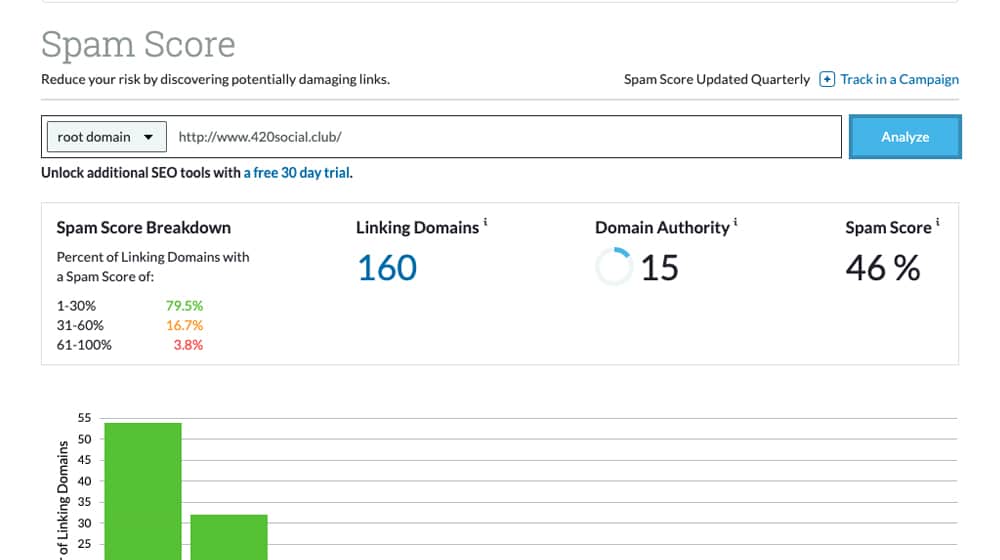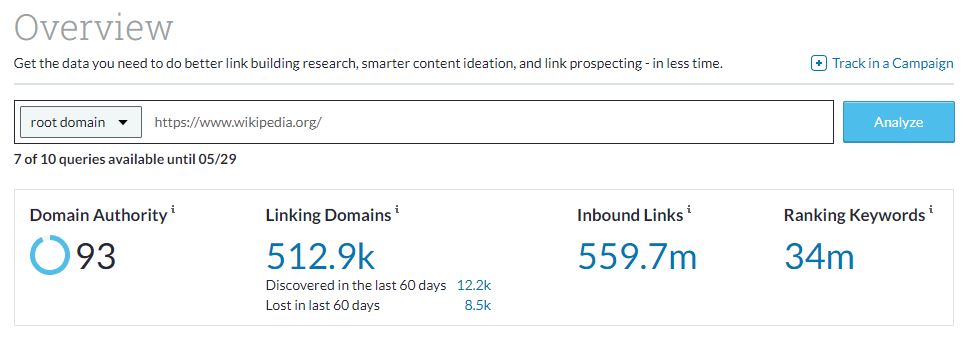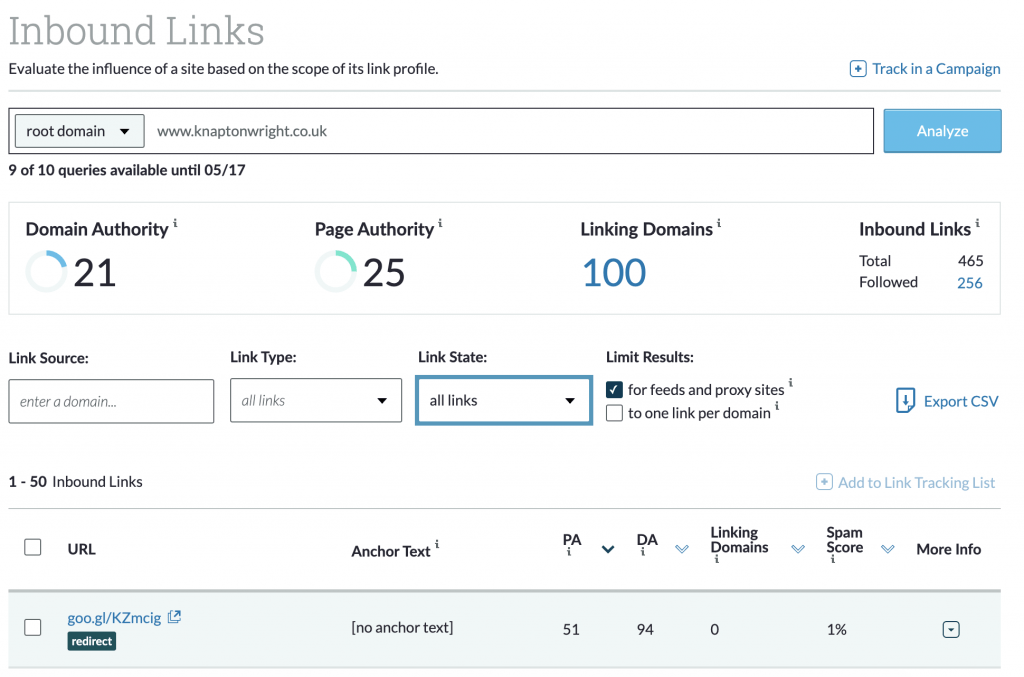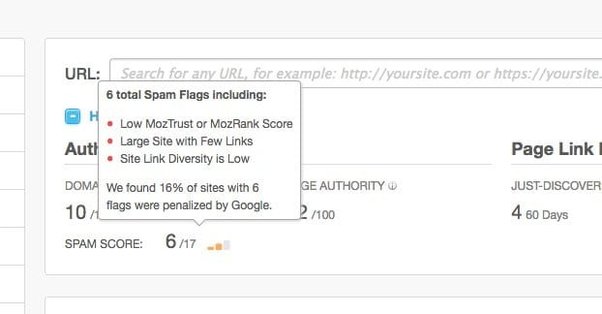Ah, spam scores. The bane of SEO’s existence and the epitome of curiosity. Yes, you’ve all been curious about your spam score, but Google doesn’t think it’s good for you to know (until now!). Spam score tells you how likely your site has been the victim of some spammy behavior from a link network or black hat operator.
The Moz Spam Score is an indicator that shows the percentage of websites that link to banned domains. It is the result of an analysis of your site’s links and can be accessed in the Link Explorer tool and the Links section of your Moz Pro Campaign. Using the Moz Spam Score, you can also determine what percentage of your links come from spam sites. By doing so, you can take the necessary steps to improve your site’s visibility.

(Image Credit: Content Powered)
How to Use Spam Score to Identify High-risk Sites?
Anything that suggests our site is or could be spam bothers us as marketers, whether it’s a link from another site that says our site is bad, a Google penalty, or a publicly available measure like Moz’s spam score. Naturally, we want to solve the problem as soon as it arises and reduce the spam score as much as possible.
First, you must understand that even a 50-60% spam score isn’t a significant cause for concern. Moz’s ranking has no bearing on anything other than the perceptions of your page’s score. It’s safe to say that Google doesn’t give it a second thought.
It may be disconcerting to see, but a spam score of 60% indicates that you have some issues on your site that need to be addressed, not that you’re about to be penalized or that your site is spam.
Your spam score isn’t that important if your site hasn’t been fined. If you want to compare your site to your competitors, you can do so, but the primary purpose of the Moz spam score is to look for potential issues with your own website.
An essential thing to remember when using spam scoring is that it only rates the likelihood of spam for subdomains (the third-level domain). It does not rank individual pages, making it difficult to identify high-risk sites among high-quality ones.
Also, it does not consider your website’s content, which may affect your website’s spam score. The spam score is based on correlation, not causation, so it is essential to understand the data. However, this algorithm is not a guarantee that your site is spam-free.
It can be a valuable tool for comparison purposes so long as you have a positive reputation. It is important to note that this feature only measures your competition’s potential problems, so it is only helpful if you’re not trying to cheat search engines.
To increase your spam score, you should ensure that your site does not have penalties or slaps. It should also have a high PageRank and domain authority, so it is essential to ensure that the content is relevant to your audience. Here is an example of a high domain authority:

(Image Credit: Hubspot Blog)
Additionally, you can use the spam score to compare your site with your competitors and determine where you can improve. The more negative attributes you have, the more likely you will be penalized, so fixing them is essential for boosting traffic and value.
Does it Matter if You Have a High Spam score?
Google penalizes sites with high spam scores, which is terrible news. But if you have yet to be penalized, you should still look at your spam score to see where your site could be improved. You can fix these problems and boost your ranking on Google.
You Might Also Like
The reason is that this metric identifies spammers. Twenty-seven factors are considered spam by the Moz algorithm, and the higher your spam score, the better. However, this doesn’t necessarily mean that your site will get penalized.
The only use for a high Spam score is to check for problems and optimize your site for more excellent search ranking, traffic, and value. To understand the importance of a high Spam score, you must know how it works.
It is a measurement of how many spammers link to your site. You’re considered a high-traffic website if you have a high spam score. But what about low-traffic sites? These sites will help lower spam scores, so you’ll want to ensure your site is as clean as possible.
The Spam Score is an indicator in the Link Explorer tool. It tells you how similar your site is to spam sites. The old scoring system only went up to 17 points but has become more granular. In general, a high Spam Score is a warning sign that your site is being analyzed.
The essential elements to consider are topical relevance and content value. After all, Moz knows quite a bit about how SEO works. If specific attributes of certain sites have been tagged as unfavorable, those attributes are most likely negative.
Even if you weren’t penalized in the first place, changing or addressing those flaws will likely result in a rise in your search ranking, traffic, and value. You can use it as a checklist of potential issues to look over across your website.
You may also utilize spam score to research any site you’re considering writing for, obtain a link from, or otherwise utilize it as a resource for your development. This is the backbone of SEO links and spam score links. Even if it doesn’t improve your SEO, a website with a high spam score referring to your site will raise your spam score.
It’s worth investigating, but it’s not designed to be a hard and fast rule that says, “disavow this link or face a punishment.” Moz has no way of knowing if you’ve disavowed links, and your spam score will still factor them in.
What is a Spam Score in SEO?
So..what IS a spam score in SEO and why should you be concerned about yours? A spam score is a valuable tool for search engine optimization. It can help you understand how your site performs compared to the competition. A spam score may only be necessary if your site is penalized.
Benefits of a Spam Score
- Optimization: Spam score is a great way to see where you can improve. Using a tool like Moz will make your website more appealing to potential customers and increase your search ranking. Using a Spam score can be beneficial in outreach.
- Disavow Bad Links: You can use it to identify spammy websites and disavow them from the Google Search Console. The Spam score can help you find these spammy websites and deny them. But remember, adding spam links to Google Search Console can hurt your website, so it’s best to use it only as a starting point.
- Avoid Being Penalized: Using a Spam score can help you understand whether an individual website page is spammy. It also prevents you from being penalized by search engines for duplicate content. The tool uses the Moz Index to analyze the individual pages of your subdomain.
- Understand Site Performance: The Spam score will then add the individual numbers of each flag to generate the final score. This helps you understand your site’s performance and whether you should take action. One of the main benefits of a Spam score is identifying spammy links.
- Check Nofollow Links: The site will be flagged as spammy if it contains more than twenty percent of no-follow links. While this may not seem a big deal if your site has never been penalized, paying attention to it is still essential. Having a high spam score can have negative consequences.
- Outreach: However, fixing these problems will not affect your ranking on Google. A high Spam score is sometimes good. It can be a valuable tool in outreach, as links are the backbone of SEO. Avoid linking to spammy sites if possible. This can hurt your website’s ranking. A Moz extension bar is a great way to start your outreach efforts. But don’t forget to use caution! The spam score is a partial picture and is only meant to serve as a guideline.
- Know Where Links Come From: While a high Spam Score doesn’t necessarily mean your site is spammy, it’s still important to know where your links are coming from. For example, you can view your links in the Link Explorer tool or the Links section of your Moz Pro Campaign.
- Track SEO Efforts: Then, you can see how many of the links are from spammy domains. Depending on the number of no-follow links on your site, your SEO efforts may be well-spent. Using a Moz Spam Score is beneficial because it allows you to take immediate action. The score updates every 30 days, which is convenient for SEO.
- Improvement Checklist: When your site hits this threshold, you’ll receive a checklist with actions to take to improve your site’s reputation. Make sure you have quality content and add a favicon to your website. It will take a month or so to see the improvement.
Spam score is not the sole determining factor for SEO ranking. It may be the best way to improve traffic, but caution is essential. If your website is flagged for spam, it may need to be in a better position to be listed in Google.
A high spam score will also indicate whether a site is safe from spammers. A website with a high spam score will likely be added to a disavow file and penalized by Google. Moreover, it will improve a site’s ranking in search engine results. A low Moz spam score will also help your website’s search rankings.
The 27 Moz Spam Score Factors
The 27 spam score factors are tools used by Google to determine whether your site is considered spam. This tool, created by Dr. Matt Peters, measures the spam-likeness of your website against a list of spam signaling factors.
Previously, this score was limited to a range of 1-17. Today, it uses a granular scale of 1 to 27, the most recent change. The 27 spam score factors are not directly related to your Google ranking. It is a proprietary metric developed by Moz, which measures 27 factors.
While a high spam score doesn’t necessarily mean your website is spam, it does suggest that it is similar to trash websites. The best thing to improve your website’s quality is to use the score as a guide.
Another important metric is the number of internal links. A website with few internal links will likely have poor-quality content or a lack of user experience. Many private blogger networks feature little to no internal links. This type of site is a prime candidate for the Spam Score algorithm. You can track your inbound links with Moz as well:

(Image Credit: Knapton Wright)
While it is not directly related to your Google ranking, it is a sign that you must improve your quality. Although the 27 Moz metric is not a direct indicator of your Google ranking, it is a valuable guide to determine your site’s overall health.
A low spam score does not mean your site is trash. It means that your site has similarities to spam-filled websites. It means that you need to improve the quality of your content to rank higher. A high spam score can be a good indication that you should focus on improving the quality of your website and preventing any further negative factors from impacting your website.
You should use all metrics as a guide rather than rely on them as a final judgment. While the spam score isn’t directly related to your Google ranking, it is a valuable metric to have. It differs from Google’s algorithm but provides a good starting point to improve your content.
It’s also a good indication of your competitors’ performance. If you’re not afraid to take risks, it’s a good sign to make a change. Lowering your spam score indicates that your site isn’t trustworthy. For example, you’re not a good candidate for link spam if you have an email and spam score.
Those who want to build a spam-free site should focus on a few factors. A low spam score can be a great indicator of a poorly maintained site if a site doesn’t have internal links.
What to Do If Your Spam Score Is Too High
You might wonder what to do if your spam score is too high. Luckily, there are some easy fixes. The first step is to examine your website to determine what may be causing the high spam score. The next step is to fix the problems.
Google rarely cracks down on spam, so it’s better to ensure lowering spam scores. It won’t hurt your SEO and spam score, so don’t worry. A spam score can affect your ranking. If it is too high, it can even result in search engines deindexing and penalizing your web pages.
While these results are bad news for your website, it is a crucial step. The good news is that it’s more than just getting backlinks from spammers. Keeping these best practices in mind can help you boost your search rankings, traffic, and value.
A high spam score doesn’t mean your site is spammy. Instead, it means that your site has some similarities to spam sites. If you’re not already facing penalties, you don’t need to make urgent changes. However, if your spam score is too high, you should look at the factors that could be causing the high spam score. For instance:

Taking the time to fix these issues will increase your search ranking and traffic, increasing your value. If you’re worried that you have a spam problem, you should investigate your site’s reputation. It’s one of many factors in your website’s ranking.
A high spam score could mean your site has a problem, so fix it immediately. You’ll be glad you did. But the first step is ensuring you have yet to receive a penalty. While the spam score isn’t a foolproof tool, it’s helpful to see which sites are risky.
You’ll be able to see which sites are high-quality and low-quality. Try to find out which ones are spammy. Generally, they all have an email and spam score. And if you’re not, it’s best to go ahead and get rid of them as soon as possible.
An essential step in improving your email and spam score is to improve your website’s performance. If your spam score is low, it’s not a problem, it’s just a performance indicator that’s important for your website.
A high spam score means that you’re doing SEO and spam score well, but it needs to indicate how well your site performs. This should be fixed quickly if you’re serious about maximizing your business’s potential.
Diib® Digital: Check Your Moz Spam Score Today!
However, there are many other factors to consider when determining which SEO and spam score plugin is right for you. At Diib®, we offer the peace of mind that comes with complete SEO analytics and performance metrics for your small business needs. Why go anywhere else when you can get all the services you need right here. Here are a few of the features of our user dashboard you’re sure to appreciate.
- Bounce rate monitoring and repair
- Social media integration and performance
- Broken pages where you have backlinks (404 checker)
- Keyword (including snippets), backlink, and indexing monitoring and tracking tools
- User experience and mobile speed optimization
- Technical SEO monitoring
Click here for your free 60 second site scan or simply call 800-303-3510 to speak to one of our growth experts.



